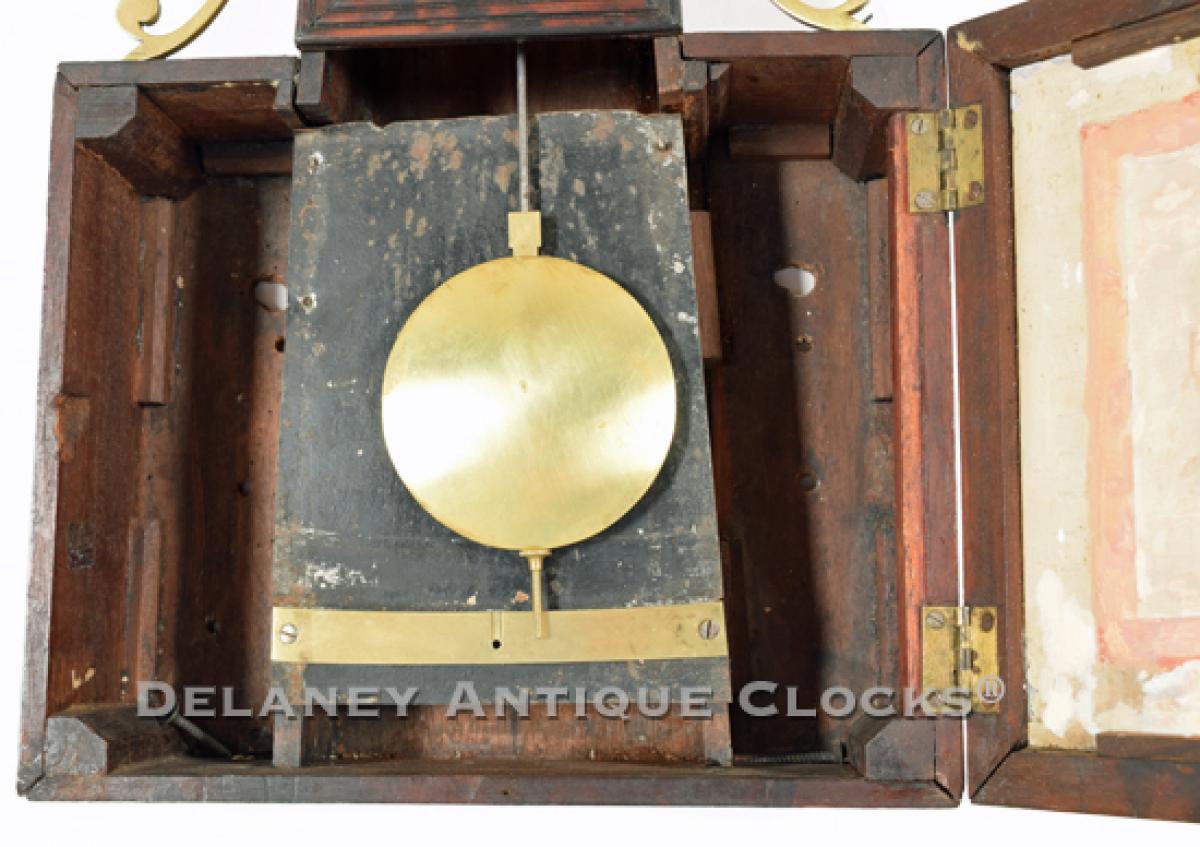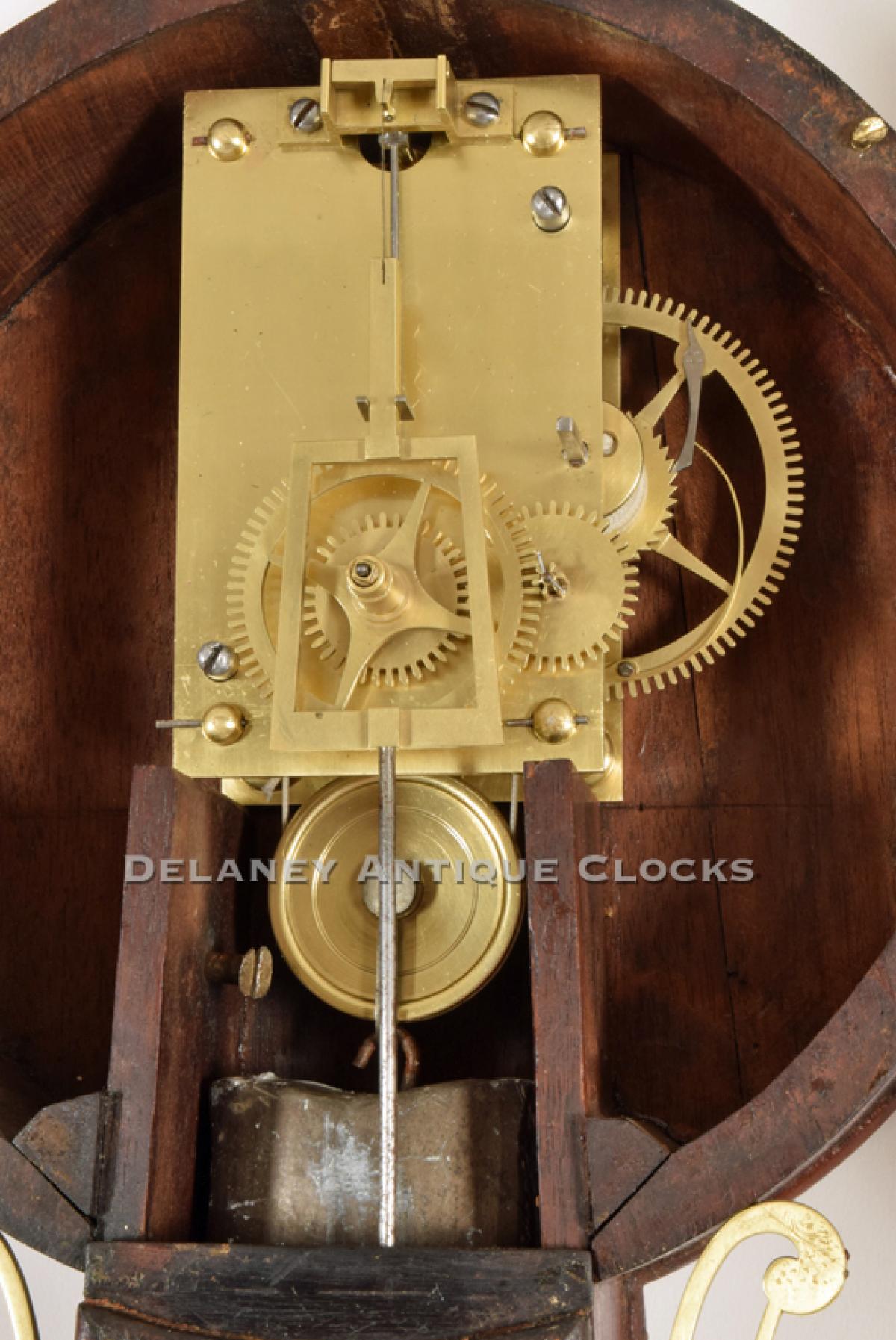Simon Willard’s Patent Timepiece or “Banjo” wall clock. This fine example is fitted with reeded frames and retains its original tablets. 218069.
This is the very form that Simon Willard famously patented in 1802. This U.S. Patent, signed by President Thomas Jefferson, provided Simon with fourteen years to produce this form exclusively. Simon’s newly engineered wall-hanging timepiece was a revolutionary design that quickly changed the clock market. This clock form is compact, reliable, and an accurate eight-day timekeeper.
This fine example was made during the last years of his patent protection period. The clock case is constructed in mahogany and exhibits excellent proportions. It features many construction characteristics that one would like to find in examples made by this famous Clockmaker. This case has the following construction and design details. The top of this case is fitted with a distinctively shaped and slightly compressed finial plinth. The head of the clock case is uniformly cut out. The glue-blocking placement in the interior of the lower box is consistent with that found in other examples signed by this Maker. This is also true of the extension blocking used in securing the lower door hinges. The joinery in the corners of the frames features a spline. The throat frame is rabbited to fit onto the throat section. The frames are unusual in that they are decorated with reeded molding. This reeded design became popular and used in the quarter columns found in the later Roxbury tall case clocks. Several other formatted timepiece examples that share this design are known to us. An Aaron Willard Jr. example that shares this frame formatting is pictured in Paul Foley’s book, Willard’s Patent Time Pieces, on page 51. There is also a Simon Willard lower frame pictured on page 188. The throat frame is secured to the case with four screws. Brass side arms flank the throat section of the case. These are hand-filed, lightly formed, and pinned to the case in three locations. The center pinning is through the center diamond. The finial and bezel are also cast brass. The bezel is fitted with glass and opens to access the painted iron dial.
The enameled dial features a closed minute track that has been relined. Roman-style numerals mark each hour. The hour and minute hands are made of steel. They are expertly hand-filed and blued.
Both of the reeded mahogany frames are fitted with paint-decorated glass tablets. These egloimise tablets are paint-decorated in multiple colors. The white field suspends several gilt designs and or patterns. These designs are executed with an expert hand. The lower tablet is signed by the Maker, ‘S. Willard’s / Patent.’ Both tablets are original to this clock and have undergone minor professional stabilization and restoration, ensuring their longevity. The skill level of this restoration is outstanding, further enhancing the clock’s quality and condition.
The time-only weight-driven movement is an eight-day brass construction design. It features large rectangular-shaped brass plates and step train gearing. The teeth in the gear train are deeply cut. A T-bridge suspension supports the pendulum. The movement is mounted to the back of the case with the original through bolts.
The cast brass eagle finial, a reproduction of an original form, surmounts the case and is mounted on a mahogany chimney plinth. The eagle finial, a symbol of strength and freedom, adds a patriotic touch to the clock’s design, enhancing its historical significance and aesthetic appeal.
This very attractive Federal Massachusetts Timepiece, or ‘Banjo clock,’ was made circa 1810. It measures approximately 34.25 inches long. This clock is not just attractive, but also rare, making it a unique addition to any collection.
Inventory number 218069.
Simon Willard was born in Grafton, Massachusetts, on April 3, 1753. He was the seventh of twelve children born to Benjamin Willard (1716-1775) and Sarah (Brooks) Willard (1717-1775) of Grafton. While living in Grafton, Simon answered the Lexington alarm on April 19, 1775, along with his brothers. It is thought that by 1782 he moved from Grafton and took up residence in Roxbury as a Clockmaker. Simon became a Master Clockmaker as well as an inventor. He is well known for receiving patents for his roasting jack in 1782, his "Improved Timepiece" or Banjo clock in 1802, and an alarm clock patent. In addition, he trained many men to make clocks who became well-known Clockmakers once their apprenticeships were served. Some of them include the brothers Levi and Able Hutchins, Elnathan Taber, William Cummens, Ezekiel Jones and Daniel Munroe. Some of the more notable public clocks Simon built include the clock in the United States Capitol building's Statuary Hall. He also built a clock for the House of Representatives and the U. S. Senate. Simon died on August 30, 1848, at the age of 95.












